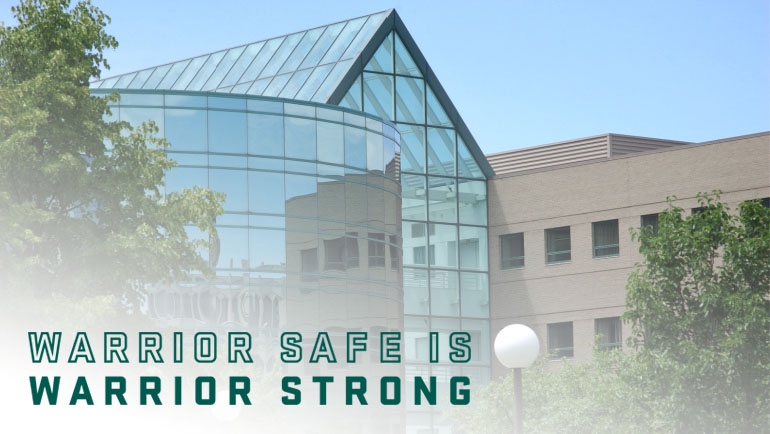
As the coronavirus pandemic continues and some students and staff return to campus for the start of fall semester, questions and concerns emerge about environmental factors, such as the quality of the air in buildings that provide space for classrooms and offices.
Wayne State’s Facilities Planning and Management (FP&M) team has traditionally employed measures to ensure that the air quality in all campus buildings is safe. In response to the pandemic, these efforts have been ramped up to address any concerns about circulating air in the campus buildings.
“The university follows the federal, state and local guidelines for indoor air quality,” said Robert Davenport, associate vice president for facilities, planning and management. “The campus buildings are designed according to standards recommended by the American Society of Heating, Refrigeration and Air-Conditioning Engineers (ASHRAE), which include the quantity of fresh air required for each person in the building, and in relation to the activities performed in the space.”
Davenport added that the university’s adherence to the ASHRAE standards also includes ASHRAE’s recently published pandemic guidelines for all occupied areas. These guidelines are acknowledged and accepted by the Centers for Disease Control and Prevention and the World Health Organization.
FP&M engineers routinely review the operations of heating, ventilation and air conditioning (HVAC) equipment to ensure that they operate properly and safely. Davenport said equipment checks are an important function in determining the air quality. “Indoor air quality starts and stops with the heating, ventilation and air conditioning equipment in the building. This is why the maintenance of these systems is a priority. And we do so via our robust preventative maintenance program.”
As the fall semester starts, the space planning side of preparation has been a priority fit testing classrooms for face-to-face classes. Typically there are more than 30 buildings used for classroom instruction. In light of the pandemic, the number has been reduced to 23 buildings that will be utilized this fall semester. That number equates to 99 classrooms that are ready for face-to-face classes.
“Fortunately, we're able to manage social distancing in this environment and we believe we've got a very excellent program to coincide with the academic mission,” Davenport said. “Indoor air quality has been addressed allowing for more fresh air, more air exchanges, increased filtration media, and cleaning those supplied diffusers.”
Steps taken to ensure maximum air quality, particularly during the pandemic, include the following regimen:
- Buildings are purged with fresh air at least 24 hours before being occupied.
- The minimum percentage of make-up air, or fresh air, circulated in the buildings has been increased from approximately 15% to approximately 20%, and air exchanges have also been increased. Make-up air is increased to levels exceeding 75% when ambient conditions — including outside temperature and humidity levels — are mild and favorable.
- Equipment run times have been extended past regular occupancy hours.
- During the times of social distancing, the number of students occupying a classroom will be reduced. This effectively means that each classroom will receive more fresh air than originally designed without necessarily changing any HVAC operating parameters.
- FP&M has upgraded to a MERV 13-rated air filter, which essentially removes more environmental impurities from fresh air and recirculated air.
- Filters have been reviewed to ensure COVID-19 guidelines are met, and the frequency at which filters are replaced complies with industry standards and environmental conditions impacting each facility.
- Conditioned air is moved to each research space, classroom and office through a supply vent or diffuser generally located in the ceiling. Although every effort is made to filter the incoming air, some vents may not appear clean. Dirt around the vents and ceiling tiles, however, are not indicative of dirty duct work. Air turbulence is the root cause. This is when fresh air exiting diffusers push tiny dirt particles within existing surrounding air, into the diffuser grills and adjacent ceiling tile. When these tiny particles accumulate, “dirt” becomes visible. The custodial teams are addressing this issue.
- Duct cleaning is performed as needed, particularly after construction projects, to ensure the indoor air quality meets industry standards.
- Cleaning crews are in the buildings daily and monitor the basic air quality and report unusual odors to the appropriate department in facilities.
- Newly renovated areas are purged with fresh air for several days in order to remove airborne contaminants from new carpeting, furniture, paint and chemicals.
- FP&M, in conjunction with the WSU Office of Environmental Health & Safety, is investigating and resolving indoor air-quality issues where identified.
- Environmental engineers and other specialists review HVAC problems that may persist in specific areas. Root-cause analysis is performed to ensure the chronic problem is identified and resolved.
“The Facilities Planning and Management team has worked tirelessly over the last few months to ensure that all of the protocols are in place to address pandemic guidelines and issues,” Davenport says. “We feel confident that the buildings are safe, not only pertaining to air quality, but other areas such as cleanliness and sterilization.”
To review the Facilities Campus Restart Playbook, including a downloadable print version and comprehensive FAQ, visit facilities.wayne.edu/covid19/playbook.
Campus employees and students may direct all questions, concerns or suggestions to fpm@wayne.edu.
This story was updated on Aug. 30, 2020.
